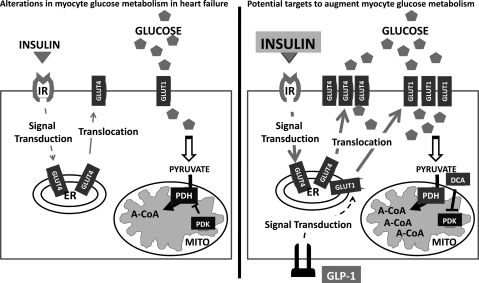Figure 2.
Insulin resistance in heart failure leads to decreased glucose uptake by cardiomyocytes via decreased translocation of GLUT4 to the sarcolemma. Fewer GLUT4 transporters result in decreased glucose flux into the myocyte. Strategies to augment glucose metabolism in heart failure include increasing glucose uptake and oxidation by the cardiomyocyte. Administration of exogenous insulin may increase GLUT4 transporter translocation. In addition, GLP-1 has been shown to increase GLUT1 translocation from intracellular vesicles to the plasma membrane. Glucose oxidation can be increased by blocking the inhibitory effects of PDK on PDH. Increased PDH activity allows for increased oxidation of pyruvate into acetyl-CoA which can enter the citric acid cycle to generate ATP. A-CoA, acetyl-CoA; DCA, dichloroacetate; ER, endoplasmic reticulum; GLP-1, glucagon-like peptide-1; GLUT4, glucose transporter type 4; IR, insulin receptor; MITO, mitochondria; PDH, pyruvate dehyrdogenase; PDK, pyruvate dehydrogenase kinase.

